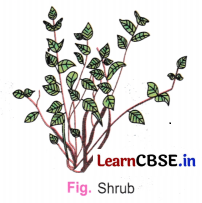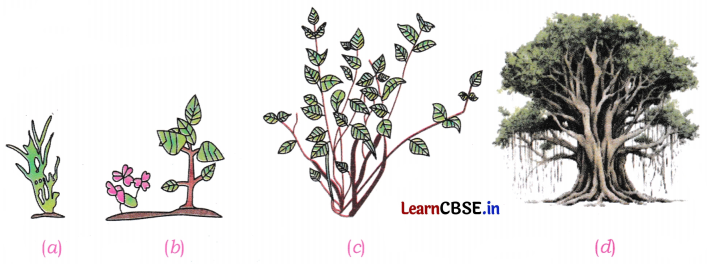Class 6 Science Chapter 2 Extra Questions and Answers Diversity in the Living World
NCERT Class 6 Science Chapter 2 Diversity in the Living World Important Extra Questions and Answers
Very Short Answer Type Questions
Question 1.
What are herbs?
Answer:
The small plants with soft tender, green, short stem are called herbs. Herbs hardly attain height more than 1.5 metres. Their stems are not woody and can be bent. A herb may or may not have branches, e.g., tomato, mint, paddy, etc.
Question 2.
With the help of diagrams, tabulate the differences between a shrub and a tree, based on the properties of the stem.
Answer:
Shrub:
- More branches arise from of stem.
- The stem is hard and thin.

Tree:
- The branches arise from the stem.
- The stem is hard, thick and woody.

Question 3.
Look carefully at the plants shown in Fig. and identify their type. Are they herbs, shrubs or trees? Are they similar in shape? Which category has the biggest plants and which has the smallest?

Answer:
Close look of these plants make it clear that these plants are not of the same type.
Plants (a) and (b) are small and have soft and thin stem. These are called herbs.
Plant (c) has many branches arising from the base and its stem is thin but hard. It is a shrub.
Plant (d) is tall. Its stem is thick and hard, it is a tree.
Question 4.
From the members of the various groups given below, find the odd one out.
(a) Coriander (dhania), mint (pudina), jamun, grass.
(b) Rose, mehndi, guava, morepankh.
Answer:
(a) Jamun (Jamun is a tree while others are herbs).
(b) Guava (Guava is a tree while others are shrubs).
Question 5.
You are shown three branches of a rose in Fig. (a), (b) and (c) (below). Which one will help you best to recognize the plant?

Rose: (a) A leafless branch,
(b) A branch with leaves, and
(c) A branch with leaves and flowers
(c) A branch with leaves and flowers.
Answer:
(c) A branch with leaves and flowers.
Question 6.
What are climbers and creepers? Give some examples.
Answer:
In some plants like grape vines, money plant, bean stalk, gourd plants, etc., the stem is so weak that it cannot hold it straight. They either stand up with some support or they just spread on the ground. The ones which climb up are called climbers. For example grape vines, money plant. The ones which spread on the ground are called creepers or runners. For example gourd plants.
Question 7.
Read the function of parts of a plant given below:
(a) fixes plant to the soil
(b) prepares starch
(c) takes part in reproduction
(d) supports branches and bears flowers
In the diagram given in Fig. write the names of the parts whose functions you have just read at the appropriate space.

Answer:

(a) Fixes plant to the soil – root.
(b) Prepares starch – leaf.
(c) Takes part in reproduction – flower.
(d) Supports branches and bears flowers – stem.
Question 8.
Why do animals move from one place to other?
Answer:
Animals move from one place to other:
(i) To obtain their food and shelter.
(ii) To protect themselves from enemies and unfavourable climate.
Question 9.
Name the organs of locomotion of:
(a) Man
(b) Bird
(c) Fish.
Answer:
(a) Man – Legs
(b) Bird – Wings
(c) Fish – Fins.
Question 10.
What is adaptation?
Answer:
The change in specific features or certain habits, which enables a plant or an animal to live in its surroundings is called adaptation.
![]()
Question 11.
What is habitat?
Answer:
The surrounding where organisms survive, flourish and reproduce is called a habitat.
Question 12.
What are aquatic habitats?
Answer:
Habitats of plants and animals that live in water are called aquatic habitat.
Question 13.
What are terrestrial habitats? Give examples.
Answer:
The plants and animals that live on land are said to live in terrestrial habitats. For example, forests, grasslands, deserts, coastal and mountain region.
Question 14.
What are biotic components?
Answer:
The living things such as plants and animals in a habitat are its biotic components.
Question 15.
Explain abiotic components.
Answer:
Various non-living things such as rocks, soil, air and water in a habitat constitute its abiotic components.
Question 16.
Classify the following habitats into terrestrial and aquatic types. Grassland, Pond, Ocean, Rice field (NCERT Exemplar)
Answer:
Terrestrial habitats-Grassland, Rice field
Aquatic habitats – Pond, Ocean
Question 17.
Write the adaptation in aquatic plants due to which
(a) Submerged leaves can bend in the flowing water.
(b) Leaves can float on the surface of water.
Answer:
(a) Leaves are narrow and ribbon like.
(b) Stems/stalks of leaves are long, hollow and light.
![]()
Question 18.
Mention one adaptation present in the following animals:
(a) In camels to keep their bodies away from the heat of sand.
(b) In frogs to enable them to swim.
(c) In dolphins and whales to breathe in air when they swim near the surface of water.
Answer:
(a) Long legs
(b) Webbed feet
(c) Blow holes
Question 19.
Some desert plants have very small leaves whereas some others have only spines. How does this benefit the plants?
Answer:
Some desert plants have very small leaves whereas some others have only spines. These are adaptations to dry conditions. As a result of these modifications the surface of lamina is reduced thereby reducing water loss by transpiration.
Question 20.
What are the specific features present in a deer that helps it to detect the presence of predators like lion?
Answer:
The specific features present in a deer that helps it to detect the presence of predators like lion are:
(a) Long ears to hear movement of predators.
(b) Eyes on the sides of its head which allow it to look in all directions.